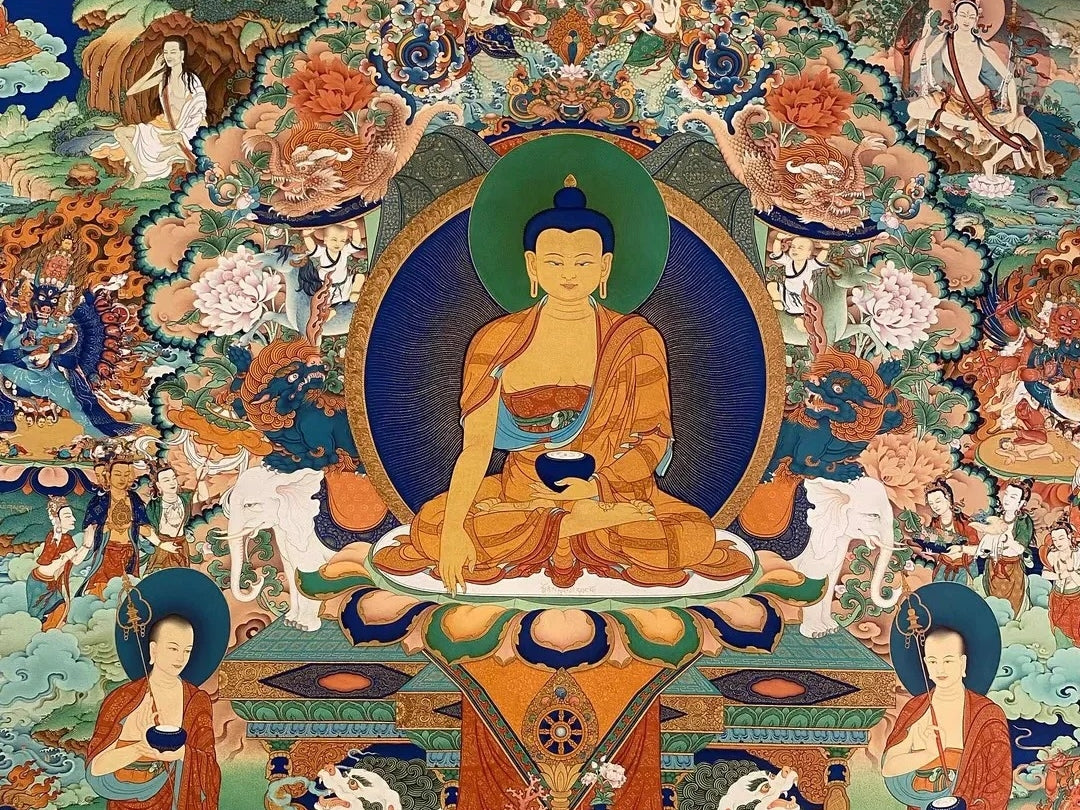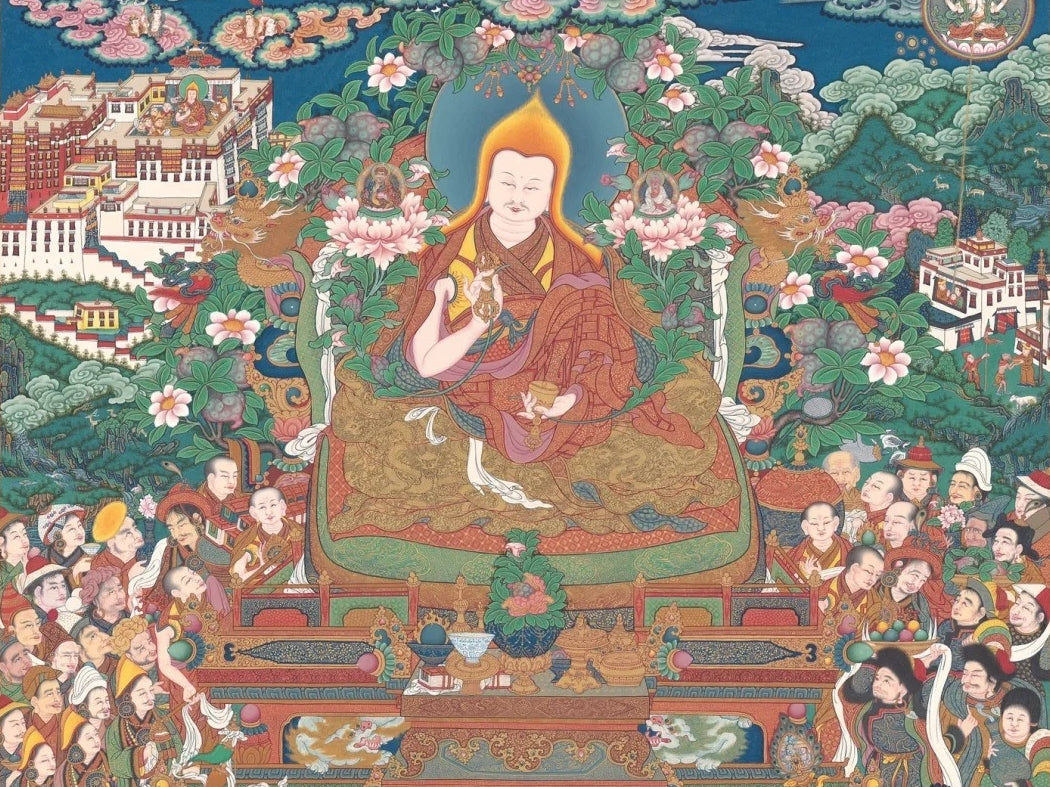Exploring the Spiritual and Artistic Significance of the Thangka Jewelry
Thangka, derived from the Tibetan word meaning "scroll painting," is an ancient art form primarily featuring religious subjects. Known for its vibrant ethnic style, profound spiritual symbolism, and unique artistic expression, Thangka is considered a cultural treasure. In Tibet, Thangkas are found in temples, shrines, and even homes, representing one of the most revered forms of Tibetan art.

Thangkas are categorized into two major types based on their material and production techniques: painted Thangkas and woven Thangkas. Painted Thangkas are created with pigments on fabric and come in various styles such as colorful Thangkas, gold Thangkas, black Thangkas, and vermilion Thangkas. The pigments are derived from natural minerals like turquoise, cinnabar, coral, malachite, and gold, ensuring that the vibrant colors do not fade, even after centuries.

Woven Thangkas, on the other hand, are made from luxurious materials like silk, brocade, and satin. They can be further divided into categories like embroidery, tapestry, appliqué, and silk brocade. Some are even embellished with gems and precious stones, adding to their opulence.

The Craft of Thangka: Precision, Devotion, and Artistry
Thangkas are renowned not only for their intricate details but also for the skill and time required to create them. The process of making a Thangka is laborious, often taking months or even years to complete. Artists must follow strict guidelines regarding composition, proportions, and color usage, as these paintings are more than just art—they are considered sacred. A master artist’s work is believed to hold spiritual power, and this belief is deeply rooted in Buddhist teachings. The artist must remain devoted to their craft, often chanting mantras and following Buddhist rituals throughout the painting process.
Thangka creation is not merely an artistic endeavor but also a spiritual practice. Unlike other art forms like painting or sculpture, Thangkas are designed to be visual aids for meditation and contemplation. When gazing upon a Thangka, one can be captivated by its complexity, vivid colors, and meticulous brushwork, but the true purpose is to delve into its spiritual meaning. By reflecting on the sacred imagery, viewers can connect to deeper Buddhist teachings and start their personal journey of spiritual growth.
The essence of Thangka lies in its faithful adherence to tradition. Deviating from established rules for artistic expression is strictly forbidden, as Thangka requires a precise representation of deities and symbols. Each aspect of the painting—from the proportions of the figures to the intricate designs—must conform to sacred Buddhist scriptures like the "Manual of Proportions for Sacred Images" (造像度量经).
The Origin of Thangka: From the Tibetan Empire to Today
Although the roots of Tibetan painting trace back more than 2,000 years, Thangkas as we know them emerged during the 7th century with the establishment of the Tibetan Empire by Songtsen Gampo (松赞干布). After uniting Tibet, Songtsen Gampo strengthened his reign by marrying Nepalese Princess Bhrikuti and Chinese Princess Wencheng (文成公主), both of whom introduced Buddhism to Tibet.
One of the earliest known records of Thangka can be found in the "Catalog of the Jokhang Temple" (《大昭寺目录》), written by the 5th Dalai Lama in the 17th century. The text mentions that Songtsen Gampo once painted an image of the goddess Palden Lhamo using his own blood, which was later enshrined in a statue’s abdomen as a core element of the deity.
The Many Types of Thangka
Thangkas can be categorized based on their materials and subjects. Painted Thangkas are created with pigments on cotton or silk canvas, using vibrant mineral colors that remain bright for centuries. Woven Thangkas, made from silk and brocade, are crafted with embroidery, tapestry, or appliqué techniques. Another type of Thangka, known as printed and colored Thangkas, involves painting, wood carving, and printing, making them somewhat similar to woodblock prints.
Subject matter in Thangka art primarily includes deities like Buddhas, bodhisattvas, and protectors. Some Thangkas depict mandalas, religious figures, historical events, or even Tibetan astrology and medicine. Approximately 80% of Thangkas are related to Tibetan Buddhism, and even those that address history or science are imbued with spiritual significance.
Thangkas as Spiritual Teaching Tools
Thangkas play a vital role in conveying complex Buddhist philosophies. As noted by Zhang Hongshi in "Exploring Tibetan Thangka" (《探索西藏唐卡》), the complexity of Buddhist teachings requires clear visual representation for better understanding. Similarly, in "The Scrolls of Tibet" (《西藏的画卷》), Qiuqi emphasizes that the primary purpose of Tibetan art is to communicate religious teachings visually. In a society where literacy rates were historically low, images like Thangkas served as essential teaching tools.
This use of visual aids is not unique to Buddhism. Even in Christianity, Pope Gregory once remarked that "what writing does for the literate, a painting does for the illiterate," echoing the importance of visual representations in religious teaching.
Additionally, unlike murals, Thangkas offer the convenience of portability. In Tibet, where nomadic lifestyles prevail, Thangkas allowed believers to carry their sacred images wherever they traveled. This mobility added to the widespread adoption of Thangka art across the region.
Due to the convenience of Thangka, Thangkas in the form of Gawu box are becoming increasingly popular among Tibetans. These compact representations offer spiritual guidance on the go, allowing individuals to carry a piece of sacred art with them at all times. This convenience has inspired products like QiLing Aura’s hand-painted Thangka pendant necklaces, blending cultural tradition with modern functionality, making it easier to integrate these spiritual symbols into daily life.

The Role of the Thangka Artist: Crafting Art with Spiritual Devotion
Creating a Thangka is a spiritual practice in itself. Traditionally, the names of artists were seldom recorded unless they were highly revered Buddhist masters, such as Atisha or Tsongkhapa. Notable Thangka painters like Lozang Tenzin from Central Tibet and Choying Gyatso from Tsang have also left a mark on Tibetan art history.
However, the anonymity of most Thangka painters is due to their belief that the process of creating the painting is a form of meditation. Artists, who are often also monks, must memorize Buddhist scriptures and iconography to faithfully depict deities and sacred symbols. Their work is not seen as personal artistic expression but as a spiritual offering.

How to Appreciate a Thangka
When viewing a Thangka, it’s essential to recognize its structured composition. A typical Thangka consists of three parts: the central deity, the celestial realm (above), and the earthly realm (below). The central figure represents the primary focus of worship, chosen by a spiritual teacher. The celestial realm is where the Buddhas and bodhisattvas reside, while the earthly realm houses protectors and ordinary beings.
Beyond its beauty, each Thangka contains layers of symbolic meaning. Every symbol, color, and image is carefully chosen to convey specific spiritual teachings. Understanding these symbols can unlock the deeper significance of the artwork, making Thangka an invaluable tool for spiritual practice.



